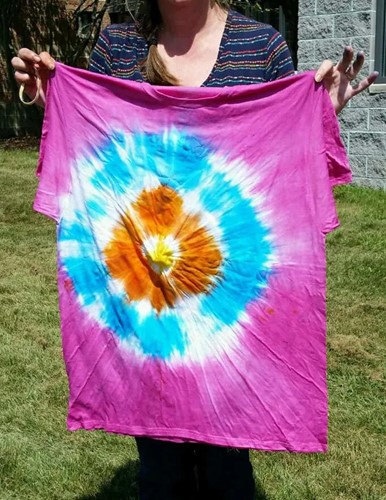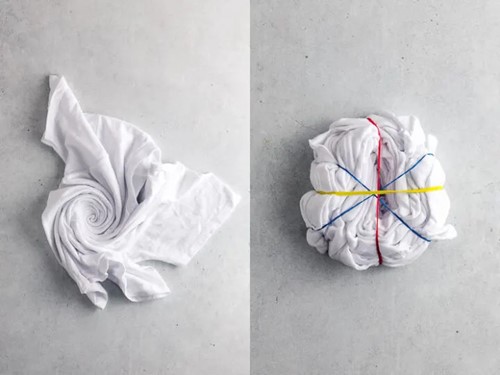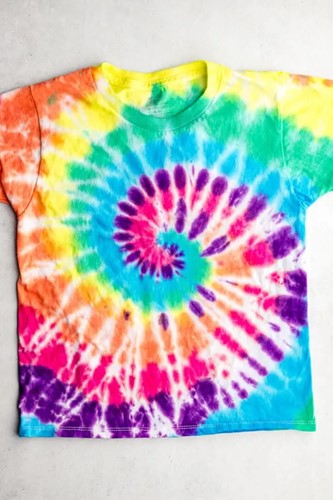More Parenting Articles
Tie Dye T-shirts Activity
By Sarah Stearns, from sarahmaker.com
Tie Dying is a fun activity you can enjoy with your little one. You can dye all sorts of garments, like shirts, jumpers, socks - even shoes!

You will need:
- fibre-reactive dye
- Plain white cotton T-shirts
- soda ash
- rubber bands or strong string
- buckets and/or squeeze bottles (1 per colour)
- plastic tablecloths
- rubber gloves and a dust mask
- Old plastic bags or cling film
Instructions
- Gather your supplies and set up your work area. Prewash your garments with detergent.
- Mix your dyes according to the package instructions. Pre-soak your garment in a soda ash solution, if necessary.
- Fold or crumple your fabric to create the design - see tie dye patterns and folding techniques. Secure the folds with rubber bands or string.
- Apply the dye solution with squeeze bottles, paintbrushes, or sponges. Or, dip the fabric in buckets of dye.
- Wrap the garments in cling film or place them in plastic bags. Let the dye set up for at least 6-8 hours, or preferably for 24 hours in a warm spot.
- Rinse in cold water, and then unfold and rinse in lukewarm water until the water runs clear. Wash separately in the washing machine with detergent.
Safety tips:
- Work outside, wear old clothes or an apron and rubber gloves.
- Wear a dust mask when mixing soda ash or dye powders.
Tie dye patterns and folding techniques


- Scrunch or Nebula
Lay the shirt flat. Scrunch the fabric together, gathering it into a tight disk. Wrap several rubber bands around the disk. The tighter you scrunch it, the more white areas there will be in the final shirt. - Swirl
Pinch a small section in the center of the shirt. Hold on to that small section while you twist the shirt clockwise. Keep twisting, and the shirt should fold in on itself like a flat cinnamon roll. Secure the shirt with 3 or 4 rubber bands, crisscrossing them over the center of the disc. The tighter you bind the shirt, the more white there will be. - Bullseye
Pinch a section of fabric at the center of the shirt. Pull the fabric up to a point, and smooth the rest of the fabric down to create a skinny cone shape. Wrap rubber bands around the cone of fabric – starting about an inch below the point of the cone. You can add as many or as few rubber bands as you want. - Sunbursts
Lay the shirt flat. Pinch a series of small sections and pull them up to create small, skinny cone shapes. Secure each with a couple of rubber bands. - Stripes
Lay the shirt flat. Starting from the bottom or one side, fold the shirt in a series of small accordion-style folds. Wrap the folded shirt with rubber bands every 1 to 2 inches. - Square Box Folds
Fold the shirt lengthwise in a series of accordion folds, each section about 3-4 inches wide. Press each fold well to get sharp creases. Then, fold the shirt widthwise in a series of accordion folds, each 3-4 wide. Sandwich the fabric between two squares of cardboard. Secure well with rubber bands. - Triangle Folds
This technique is very similar to the previous technique. In the second step, you’ll fold the strip of fabric into triangles instead of squares. Then, sandwich the fabric between two triangles of cardboard. Secure well with rubber bands. - Kaleidoscope or Mandalas
For this look, you’ll be creating a design with one or two lines of symmetry. Lay the shirt out on the table and fold it in half lengthwise and then again widthwise. After the shirt is folding in quarters, you can secure the shirt in whatever pattern you like. - Ombre Dip-Dye
For this technique, you don’t have to fold the fabric. Simply dip one end of the shirt into a bucket of dye. As it sits in the dye bath, the dye will slowly work its way up the fabric. You can repeat this process by dipping the other end of the fabric into a different color of dye. - Heart
First, fold the shirt in half lengthwise. Draw half a heart shape on the fold with a washable marker. Starting at one end of your line, make small accordion pleats. Follow the drawn line, making the pleats so that the line appears straight at the top of the folds. (You’ll be making the folds a little deeper on the outside section and a little shallower on the inside section to accommodate the curve of the line.) When all of the fabric has been pleated, secure it with a thick rubber band placed on the line itself. Then, you can add more rubber bands on the inside or outside sections as desired.
-------------------
Content kindly provided with permission for re-publishing by Sarah Stearns.
Sarah Stearns has helped thousands of makers find their next craft project with free patterns and step-by-step tutorials on her blog, sarahmaker.com.